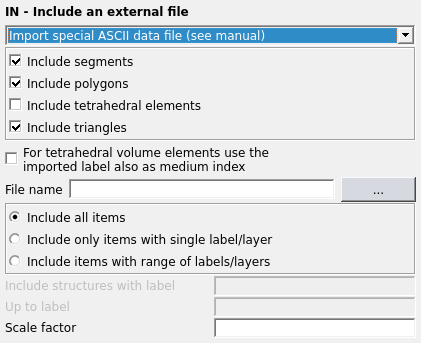Import Special ASCII Data File
This option is used to import meshes stored in the geometry data file as specified below.

Figure 1. The IN - Include an external file (Special ASCII data file) dialog.
The ASCII format supports segments, triangles, tetrahedra and polygonal plates, but all other (non-selection) parameters discussed in the general section of the IN card above apply. In this case the label is specified directly in the file and no conversion is required.
Dielectric triangles or metallic triangles which form the surface of a dielectric, are created by preceding the IN card with the appropriate ME card. (In exactly the same way as is the case without the IN card.)
The data of the segments, triangles and polygonal plates are given in an ASCII file, formatted as shown below. There is no need to adhere to specific columns, the data fields merely have to be separated by one or more spaces.
nk nd ns np nt
x(1) y(1) z(1) (String_name)
x(2) y(2) z(2) (String_name)
...
x(nk) y(nk) z(nk) (String_name)
d1(1) d2(1) d3(1) 0 (Label)
d1(2) d2(2) d3(2) 0 (Label)
...
d1(nd) d2(nd) d3(nd) 0 (Label)
s1(1) s2(1) 0 0 (Label)
s1(2) s2(2) 0 0 (Label)
...
s1(ns) s2(ns) 0 0 (Label)
nnp(1) p1(1) p2(1) p3(1) ... (Label)
nnp(2) p1(2) p2(2) p3(2) ... (Label)
...
nnp(np) p1(np) p2(np) p3(np) ... (Label)
t1(1) t2(1) t3(1) t4(1) (Label)
t1(2) t2(2) t3(2) t4(2) (Label)
...
t1(nt) t2(nt) t3(nt) t4(nt) (Label)nk- Number of nodes.
nd- Number of triangles.
ns- Number of segments.
np- Number of polygonal plates.
nt- Number of tetrahedral volume elements (defaults to 0 if not specified).
x(i)- X coordinates of node i in metre (is scaled by the SF card).
y(i)- Y coordinates of node i in metre (is scaled by the SF card).
z(i)- Z coordinates of node i in metre (is scaled by the SF card).
d1(j)- Number (index) of the first vertex of triangle j.
d2(j)- Number (index) of the second vertex of triangle j.
d3(j)- Number (index) of the third vertex of triangle j.
s1(k)- Number (index) of the starting point of segment k
s2(k)- Number (index) of the end point of segment k
nnp(m)- Number of corner points in polygon metre.
p1(m)- Number (index) of the first corner of polygon metre.
p2(m)- Number (index) of the second corner of polygon metre.
p3(m)- Number (index) of the third corner of polygon metre.
t1(m)- Number (index) of the first corner of tetrahedron metre.
t2(m)- Number (index) of the second corner of tetrahedron metre.
t3(m)- Number (index) of the third corner of tetrahedron metre.
t4(m)- Number (index) of the fourth corner of tetrahedron metre.
...- Number (index) of the additional corners of polygon metre.
String_name- Optional string name of the point. It must be a string of up to five characters, similar to the point name of the DP card. If a point is named, it can be used in any card following the IN card.
Label- Specifying the label as the last parameter of any structure is optional.
If no label is specified, the value defined at the last LA card will be
used. Note: That if a label or range of labels is specified (with parameters after the file name), this LA card label will be used to determine if a structure is included or not.
The radius of segments must be specified by an IP card before the IN card. It is recommended to check the geometry with POSTFEKO.
Example
The structure in Figure 2, consisting of 5 node points and 3 triangles with label 7 (no segments or polygonal plates), may be imported from the following data file
5 3 0 0
3.0 0.0 1.0
4.0 2.0 1.0
2.5 3.0 2.5
0.0 3.0 4.0
1.0 0.0 3.0
1 2 3 0 7
1 3 5 0 7
3 4 5 0 7
Figure 2. Example of a structure with 5 node points and 3 triangles created with the IN card.